Organizational Strategy Report
VerifiedAdded on 2023/01/18
|15
|3618
|32
AI Summary
This report provides an analysis of the challenges faced by Adnams, a brewing company in the UK, and explores strategic options for its future growth. It covers key aspects of Adnams' internal business operations, industry and sector analysis, and recommendations for sustaining growth.
Contribute Materials
Your contribution can guide someone’s learning journey. Share your
documents today.
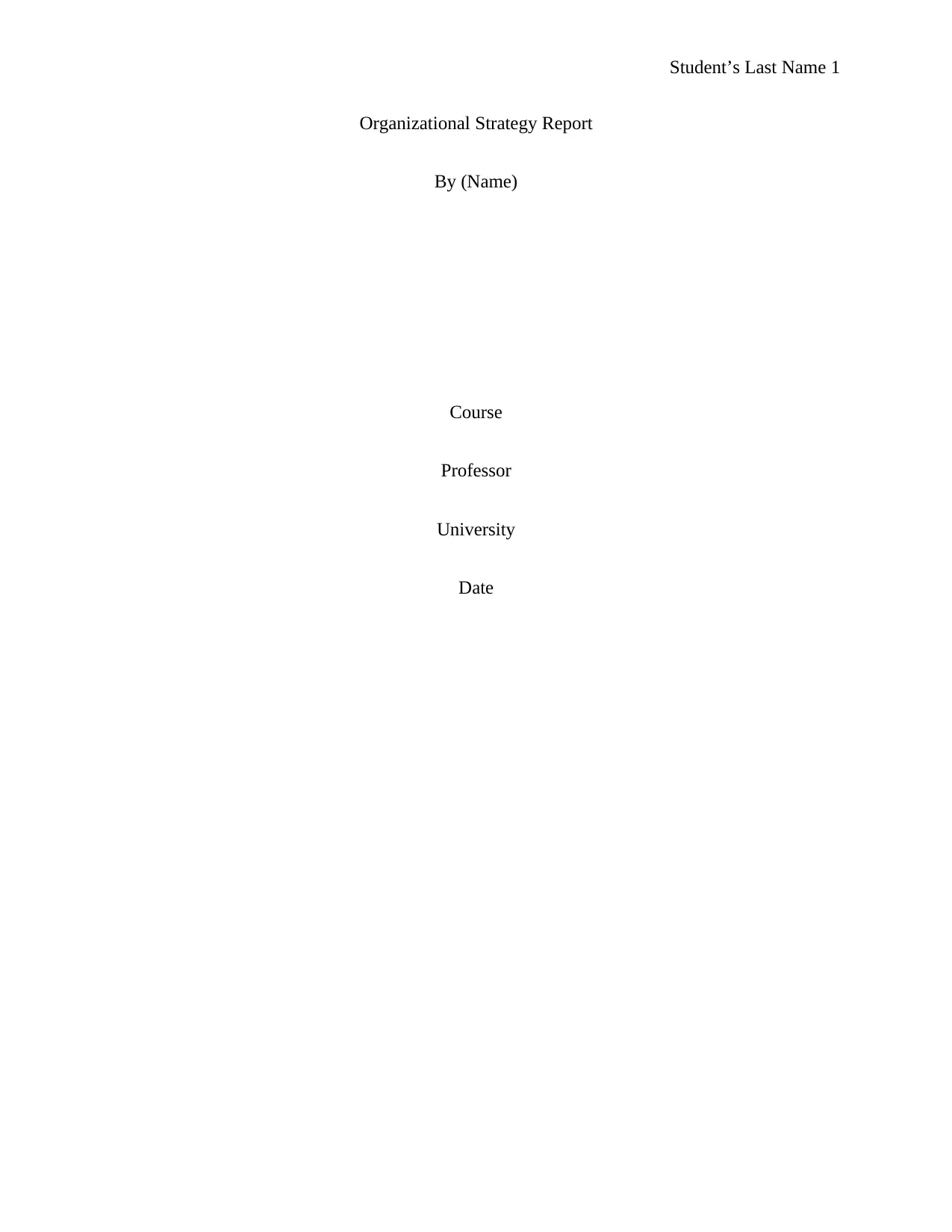
Student’s Last Name 1
Organizational Strategy Report
By (Name)
Course
Professor
University
Date
Organizational Strategy Report
By (Name)
Course
Professor
University
Date
Secure Best Marks with AI Grader
Need help grading? Try our AI Grader for instant feedback on your assignments.

Student’s Last Name 2
Executive summary
Adnams is a brewing company located in Southold, UK. The company’s positioning
strategies have assisted it to thrive despite many challenges in the market place. Some of the
challenges experienced include, increased competition, the availability of substitutes, including
the increased demand from the buyers. The report is divided into four sections: key challenges
experienced by Adnams, key aspects of Adnam’s internal business operations, and strategic
options as well as directions that Adnams can consider in sustaining its future growth. The last
part provides recommendations that can help develop Adnams over the next ten years.
Table of Contents
Executive summary
Adnams is a brewing company located in Southold, UK. The company’s positioning
strategies have assisted it to thrive despite many challenges in the market place. Some of the
challenges experienced include, increased competition, the availability of substitutes, including
the increased demand from the buyers. The report is divided into four sections: key challenges
experienced by Adnams, key aspects of Adnam’s internal business operations, and strategic
options as well as directions that Adnams can consider in sustaining its future growth. The last
part provides recommendations that can help develop Adnams over the next ten years.
Table of Contents
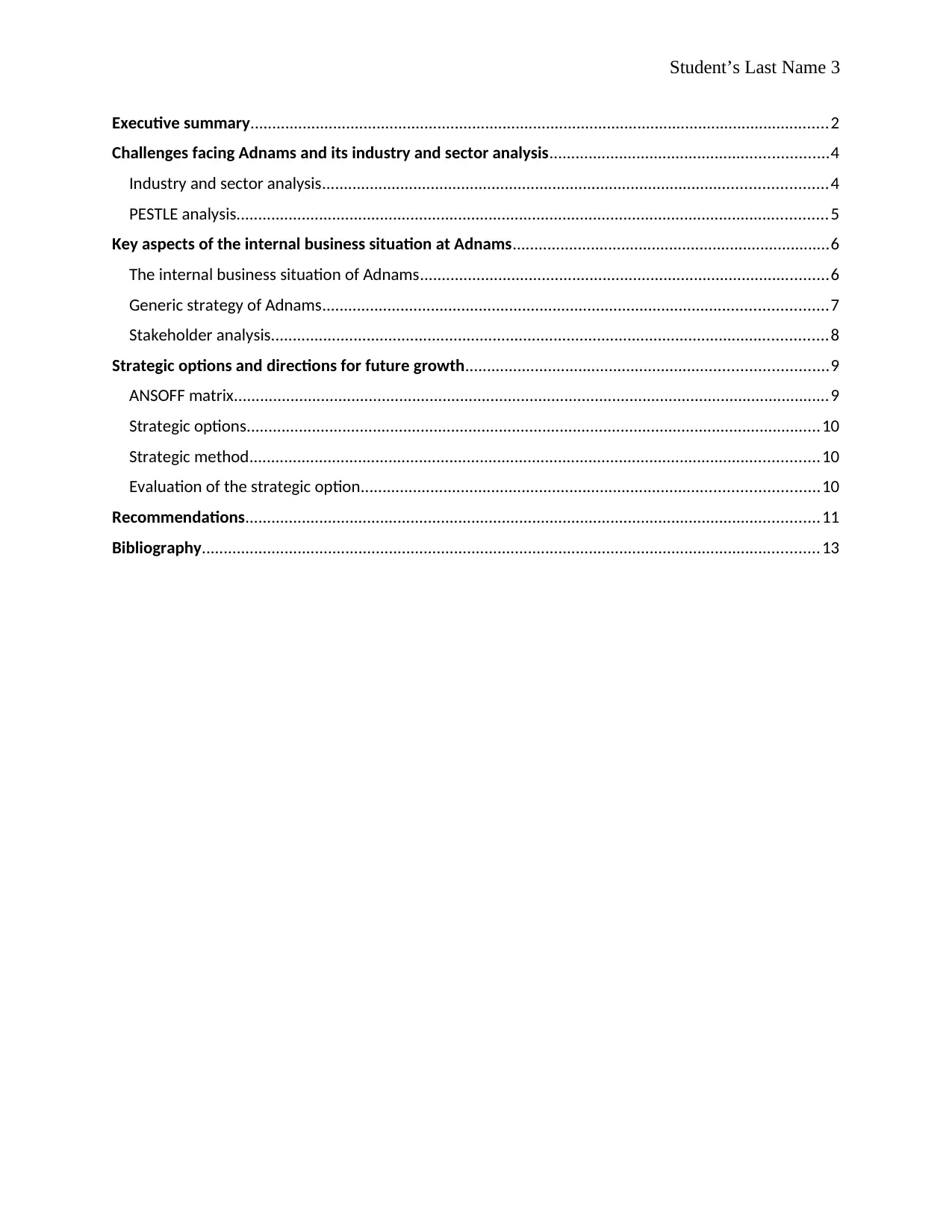
Student’s Last Name 3
Executive summary.....................................................................................................................................2
Challenges facing Adnams and its industry and sector analysis................................................................4
Industry and sector analysis....................................................................................................................4
PESTLE analysis........................................................................................................................................5
Key aspects of the internal business situation at Adnams.........................................................................6
The internal business situation of Adnams..............................................................................................6
Generic strategy of Adnams....................................................................................................................7
Stakeholder analysis................................................................................................................................8
Strategic options and directions for future growth...................................................................................9
ANSOFF matrix.........................................................................................................................................9
Strategic options....................................................................................................................................10
Strategic method...................................................................................................................................10
Evaluation of the strategic option.........................................................................................................10
Recommendations....................................................................................................................................11
Bibliography..............................................................................................................................................13
Executive summary.....................................................................................................................................2
Challenges facing Adnams and its industry and sector analysis................................................................4
Industry and sector analysis....................................................................................................................4
PESTLE analysis........................................................................................................................................5
Key aspects of the internal business situation at Adnams.........................................................................6
The internal business situation of Adnams..............................................................................................6
Generic strategy of Adnams....................................................................................................................7
Stakeholder analysis................................................................................................................................8
Strategic options and directions for future growth...................................................................................9
ANSOFF matrix.........................................................................................................................................9
Strategic options....................................................................................................................................10
Strategic method...................................................................................................................................10
Evaluation of the strategic option.........................................................................................................10
Recommendations....................................................................................................................................11
Bibliography..............................................................................................................................................13
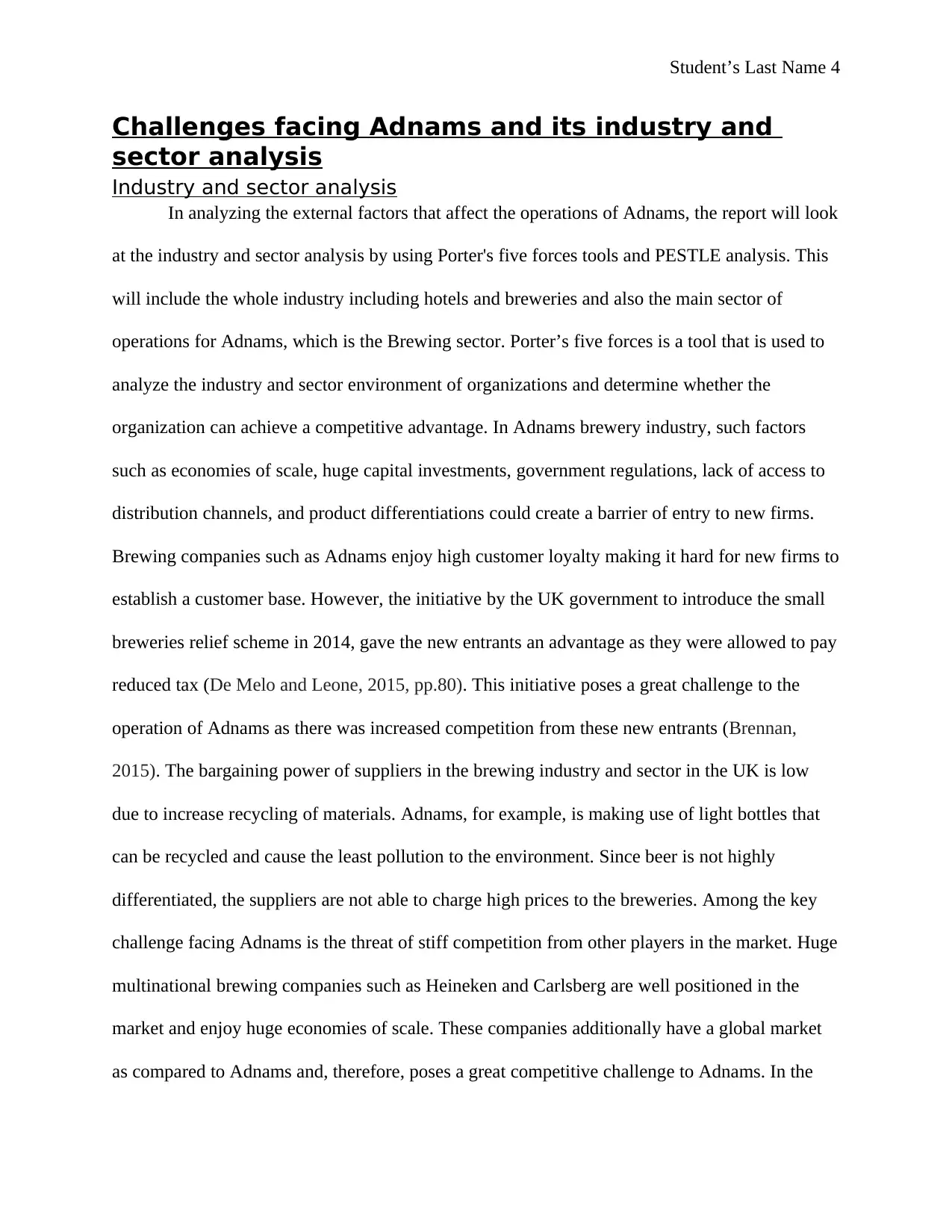
Student’s Last Name 4
Challenges facing Adnams and its industry and
sector analysis
Industry and sector analysis
In analyzing the external factors that affect the operations of Adnams, the report will look
at the industry and sector analysis by using Porter's five forces tools and PESTLE analysis. This
will include the whole industry including hotels and breweries and also the main sector of
operations for Adnams, which is the Brewing sector. Porter’s five forces is a tool that is used to
analyze the industry and sector environment of organizations and determine whether the
organization can achieve a competitive advantage. In Adnams brewery industry, such factors
such as economies of scale, huge capital investments, government regulations, lack of access to
distribution channels, and product differentiations could create a barrier of entry to new firms.
Brewing companies such as Adnams enjoy high customer loyalty making it hard for new firms to
establish a customer base. However, the initiative by the UK government to introduce the small
breweries relief scheme in 2014, gave the new entrants an advantage as they were allowed to pay
reduced tax (De Melo and Leone, 2015, pp.80). This initiative poses a great challenge to the
operation of Adnams as there was increased competition from these new entrants (Brennan,
2015). The bargaining power of suppliers in the brewing industry and sector in the UK is low
due to increase recycling of materials. Adnams, for example, is making use of light bottles that
can be recycled and cause the least pollution to the environment. Since beer is not highly
differentiated, the suppliers are not able to charge high prices to the breweries. Among the key
challenge facing Adnams is the threat of stiff competition from other players in the market. Huge
multinational brewing companies such as Heineken and Carlsberg are well positioned in the
market and enjoy huge economies of scale. These companies additionally have a global market
as compared to Adnams and, therefore, poses a great competitive challenge to Adnams. In the
Challenges facing Adnams and its industry and
sector analysis
Industry and sector analysis
In analyzing the external factors that affect the operations of Adnams, the report will look
at the industry and sector analysis by using Porter's five forces tools and PESTLE analysis. This
will include the whole industry including hotels and breweries and also the main sector of
operations for Adnams, which is the Brewing sector. Porter’s five forces is a tool that is used to
analyze the industry and sector environment of organizations and determine whether the
organization can achieve a competitive advantage. In Adnams brewery industry, such factors
such as economies of scale, huge capital investments, government regulations, lack of access to
distribution channels, and product differentiations could create a barrier of entry to new firms.
Brewing companies such as Adnams enjoy high customer loyalty making it hard for new firms to
establish a customer base. However, the initiative by the UK government to introduce the small
breweries relief scheme in 2014, gave the new entrants an advantage as they were allowed to pay
reduced tax (De Melo and Leone, 2015, pp.80). This initiative poses a great challenge to the
operation of Adnams as there was increased competition from these new entrants (Brennan,
2015). The bargaining power of suppliers in the brewing industry and sector in the UK is low
due to increase recycling of materials. Adnams, for example, is making use of light bottles that
can be recycled and cause the least pollution to the environment. Since beer is not highly
differentiated, the suppliers are not able to charge high prices to the breweries. Among the key
challenge facing Adnams is the threat of stiff competition from other players in the market. Huge
multinational brewing companies such as Heineken and Carlsberg are well positioned in the
market and enjoy huge economies of scale. These companies additionally have a global market
as compared to Adnams and, therefore, poses a great competitive challenge to Adnams. In the
Secure Best Marks with AI Grader
Need help grading? Try our AI Grader for instant feedback on your assignments.
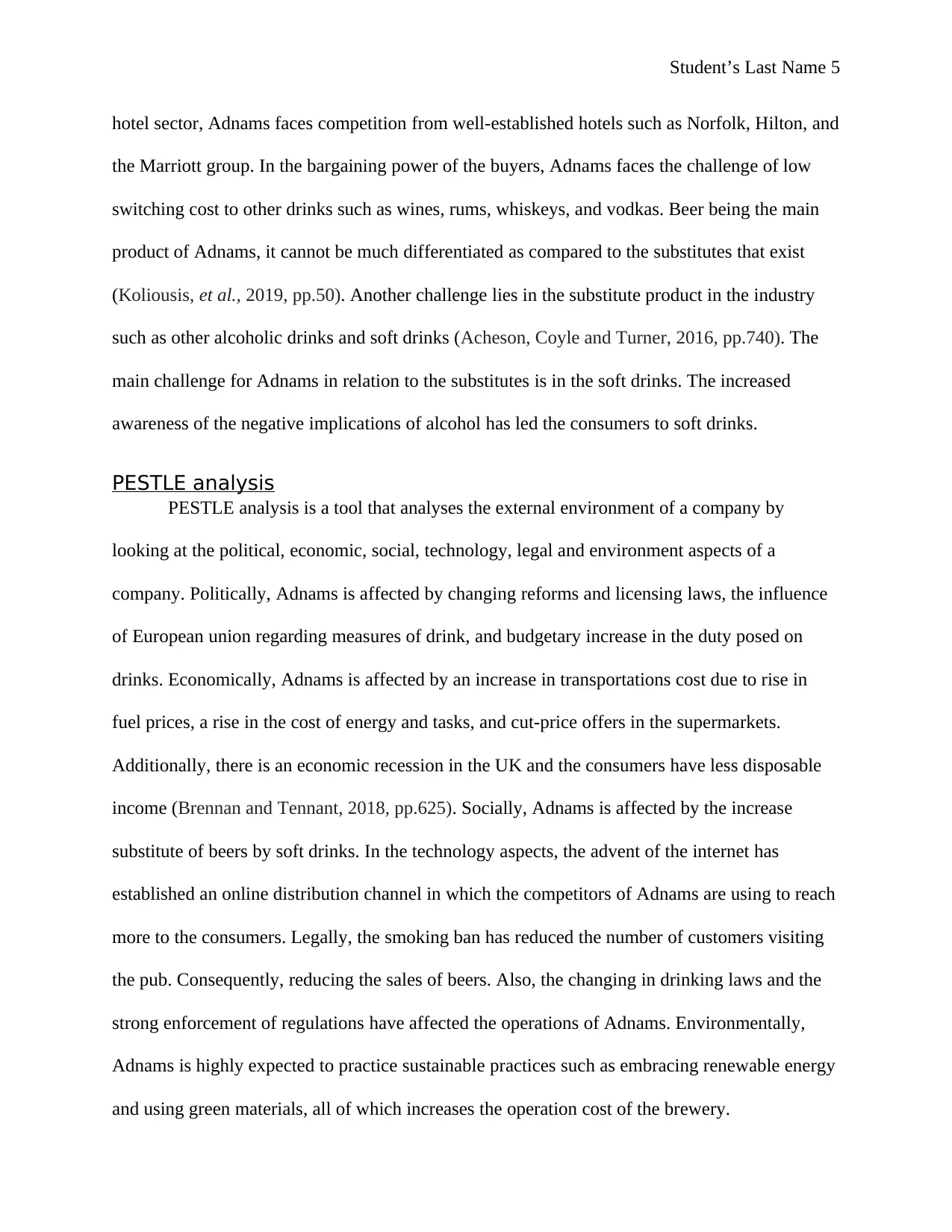
Student’s Last Name 5
hotel sector, Adnams faces competition from well-established hotels such as Norfolk, Hilton, and
the Marriott group. In the bargaining power of the buyers, Adnams faces the challenge of low
switching cost to other drinks such as wines, rums, whiskeys, and vodkas. Beer being the main
product of Adnams, it cannot be much differentiated as compared to the substitutes that exist
(Koliousis, et al., 2019, pp.50). Another challenge lies in the substitute product in the industry
such as other alcoholic drinks and soft drinks (Acheson, Coyle and Turner, 2016, pp.740). The
main challenge for Adnams in relation to the substitutes is in the soft drinks. The increased
awareness of the negative implications of alcohol has led the consumers to soft drinks.
PESTLE analysis
PESTLE analysis is a tool that analyses the external environment of a company by
looking at the political, economic, social, technology, legal and environment aspects of a
company. Politically, Adnams is affected by changing reforms and licensing laws, the influence
of European union regarding measures of drink, and budgetary increase in the duty posed on
drinks. Economically, Adnams is affected by an increase in transportations cost due to rise in
fuel prices, a rise in the cost of energy and tasks, and cut-price offers in the supermarkets.
Additionally, there is an economic recession in the UK and the consumers have less disposable
income (Brennan and Tennant, 2018, pp.625). Socially, Adnams is affected by the increase
substitute of beers by soft drinks. In the technology aspects, the advent of the internet has
established an online distribution channel in which the competitors of Adnams are using to reach
more to the consumers. Legally, the smoking ban has reduced the number of customers visiting
the pub. Consequently, reducing the sales of beers. Also, the changing in drinking laws and the
strong enforcement of regulations have affected the operations of Adnams. Environmentally,
Adnams is highly expected to practice sustainable practices such as embracing renewable energy
and using green materials, all of which increases the operation cost of the brewery.
hotel sector, Adnams faces competition from well-established hotels such as Norfolk, Hilton, and
the Marriott group. In the bargaining power of the buyers, Adnams faces the challenge of low
switching cost to other drinks such as wines, rums, whiskeys, and vodkas. Beer being the main
product of Adnams, it cannot be much differentiated as compared to the substitutes that exist
(Koliousis, et al., 2019, pp.50). Another challenge lies in the substitute product in the industry
such as other alcoholic drinks and soft drinks (Acheson, Coyle and Turner, 2016, pp.740). The
main challenge for Adnams in relation to the substitutes is in the soft drinks. The increased
awareness of the negative implications of alcohol has led the consumers to soft drinks.
PESTLE analysis
PESTLE analysis is a tool that analyses the external environment of a company by
looking at the political, economic, social, technology, legal and environment aspects of a
company. Politically, Adnams is affected by changing reforms and licensing laws, the influence
of European union regarding measures of drink, and budgetary increase in the duty posed on
drinks. Economically, Adnams is affected by an increase in transportations cost due to rise in
fuel prices, a rise in the cost of energy and tasks, and cut-price offers in the supermarkets.
Additionally, there is an economic recession in the UK and the consumers have less disposable
income (Brennan and Tennant, 2018, pp.625). Socially, Adnams is affected by the increase
substitute of beers by soft drinks. In the technology aspects, the advent of the internet has
established an online distribution channel in which the competitors of Adnams are using to reach
more to the consumers. Legally, the smoking ban has reduced the number of customers visiting
the pub. Consequently, reducing the sales of beers. Also, the changing in drinking laws and the
strong enforcement of regulations have affected the operations of Adnams. Environmentally,
Adnams is highly expected to practice sustainable practices such as embracing renewable energy
and using green materials, all of which increases the operation cost of the brewery.
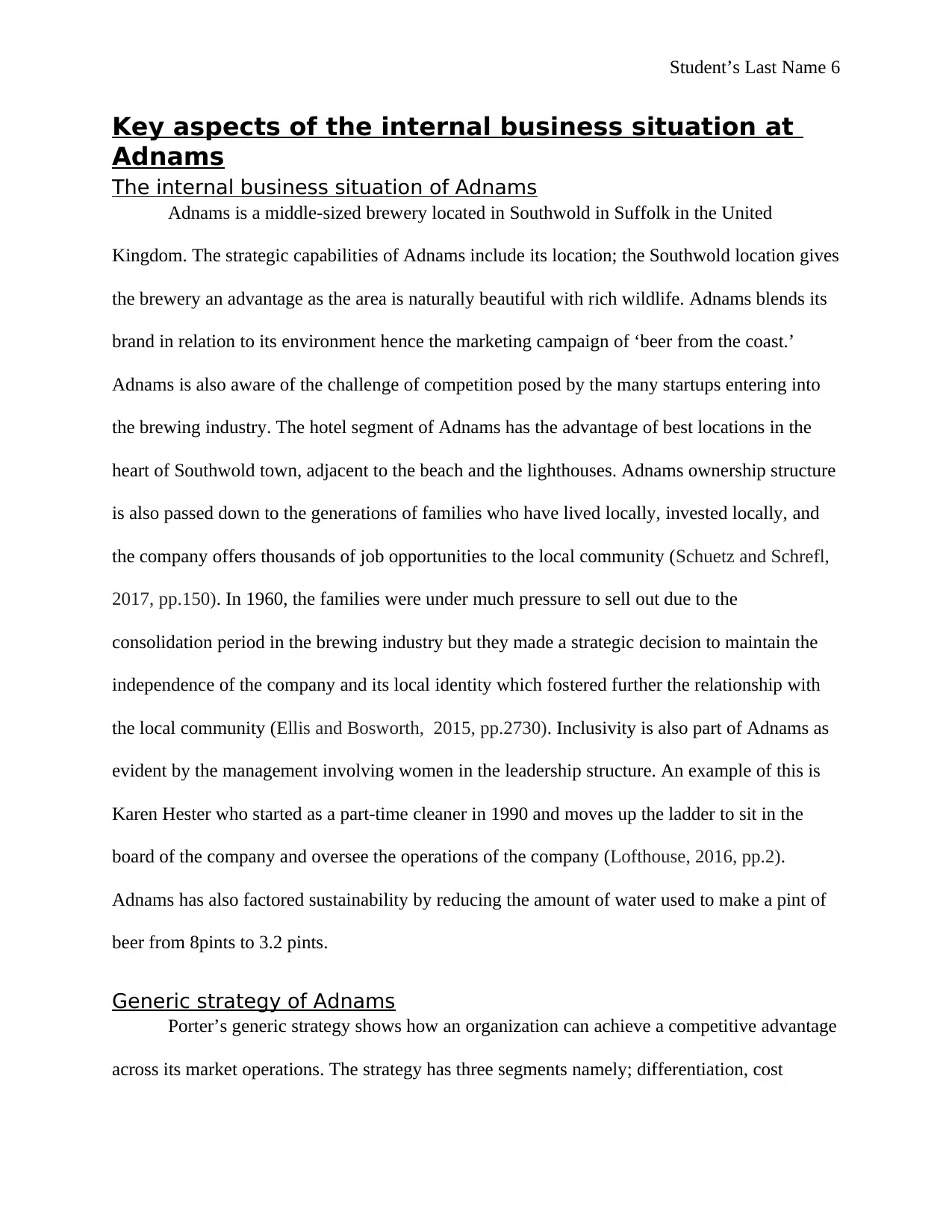
Student’s Last Name 6
Key aspects of the internal business situation at
Adnams
The internal business situation of Adnams
Adnams is a middle-sized brewery located in Southwold in Suffolk in the United
Kingdom. The strategic capabilities of Adnams include its location; the Southwold location gives
the brewery an advantage as the area is naturally beautiful with rich wildlife. Adnams blends its
brand in relation to its environment hence the marketing campaign of ‘beer from the coast.’
Adnams is also aware of the challenge of competition posed by the many startups entering into
the brewing industry. The hotel segment of Adnams has the advantage of best locations in the
heart of Southwold town, adjacent to the beach and the lighthouses. Adnams ownership structure
is also passed down to the generations of families who have lived locally, invested locally, and
the company offers thousands of job opportunities to the local community (Schuetz and Schrefl,
2017, pp.150). In 1960, the families were under much pressure to sell out due to the
consolidation period in the brewing industry but they made a strategic decision to maintain the
independence of the company and its local identity which fostered further the relationship with
the local community (Ellis and Bosworth, 2015, pp.2730). Inclusivity is also part of Adnams as
evident by the management involving women in the leadership structure. An example of this is
Karen Hester who started as a part-time cleaner in 1990 and moves up the ladder to sit in the
board of the company and oversee the operations of the company (Lofthouse, 2016, pp.2).
Adnams has also factored sustainability by reducing the amount of water used to make a pint of
beer from 8pints to 3.2 pints.
Generic strategy of Adnams
Porter’s generic strategy shows how an organization can achieve a competitive advantage
across its market operations. The strategy has three segments namely; differentiation, cost
Key aspects of the internal business situation at
Adnams
The internal business situation of Adnams
Adnams is a middle-sized brewery located in Southwold in Suffolk in the United
Kingdom. The strategic capabilities of Adnams include its location; the Southwold location gives
the brewery an advantage as the area is naturally beautiful with rich wildlife. Adnams blends its
brand in relation to its environment hence the marketing campaign of ‘beer from the coast.’
Adnams is also aware of the challenge of competition posed by the many startups entering into
the brewing industry. The hotel segment of Adnams has the advantage of best locations in the
heart of Southwold town, adjacent to the beach and the lighthouses. Adnams ownership structure
is also passed down to the generations of families who have lived locally, invested locally, and
the company offers thousands of job opportunities to the local community (Schuetz and Schrefl,
2017, pp.150). In 1960, the families were under much pressure to sell out due to the
consolidation period in the brewing industry but they made a strategic decision to maintain the
independence of the company and its local identity which fostered further the relationship with
the local community (Ellis and Bosworth, 2015, pp.2730). Inclusivity is also part of Adnams as
evident by the management involving women in the leadership structure. An example of this is
Karen Hester who started as a part-time cleaner in 1990 and moves up the ladder to sit in the
board of the company and oversee the operations of the company (Lofthouse, 2016, pp.2).
Adnams has also factored sustainability by reducing the amount of water used to make a pint of
beer from 8pints to 3.2 pints.
Generic strategy of Adnams
Porter’s generic strategy shows how an organization can achieve a competitive advantage
across its market operations. The strategy has three segments namely; differentiation, cost
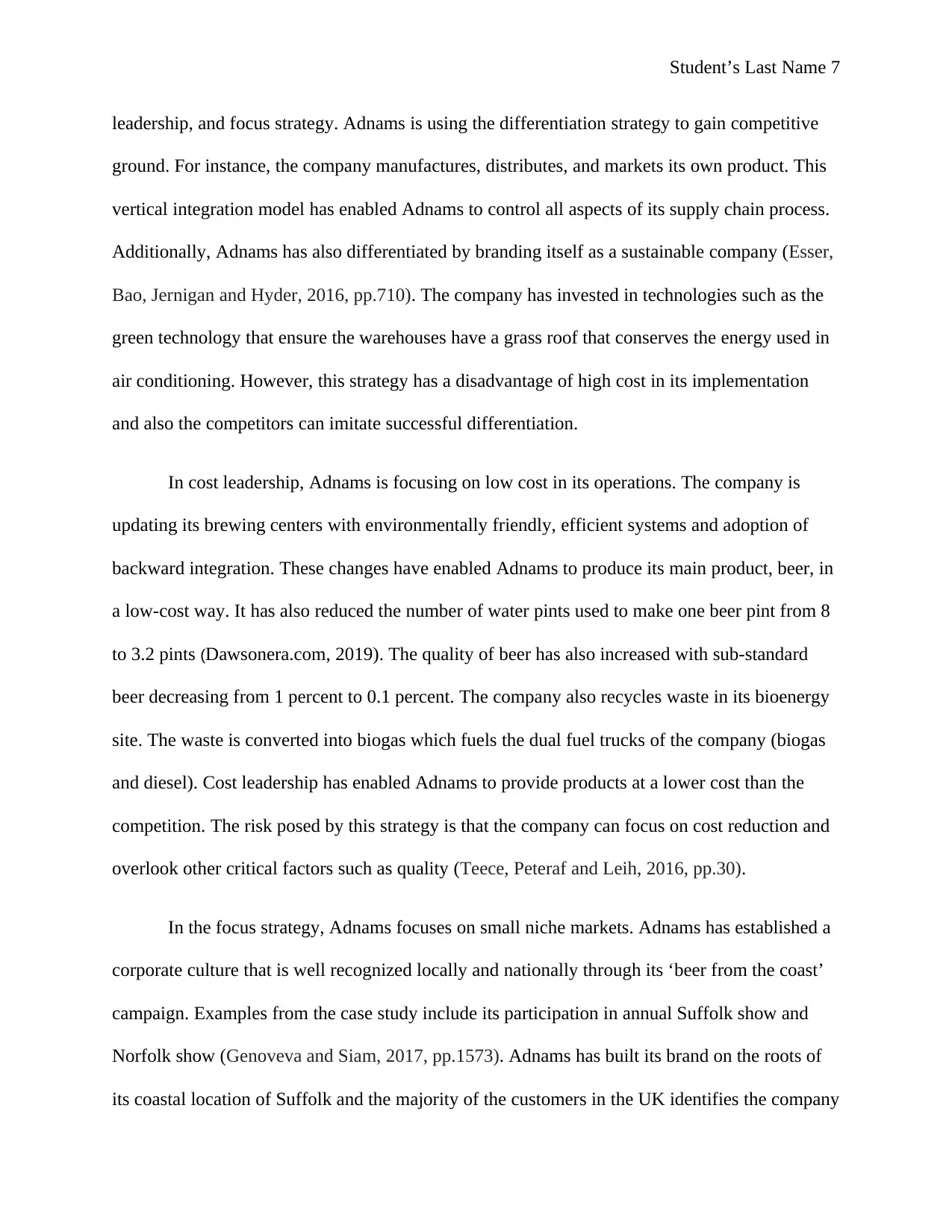
Student’s Last Name 7
leadership, and focus strategy. Adnams is using the differentiation strategy to gain competitive
ground. For instance, the company manufactures, distributes, and markets its own product. This
vertical integration model has enabled Adnams to control all aspects of its supply chain process.
Additionally, Adnams has also differentiated by branding itself as a sustainable company (Esser,
Bao, Jernigan and Hyder, 2016, pp.710). The company has invested in technologies such as the
green technology that ensure the warehouses have a grass roof that conserves the energy used in
air conditioning. However, this strategy has a disadvantage of high cost in its implementation
and also the competitors can imitate successful differentiation.
In cost leadership, Adnams is focusing on low cost in its operations. The company is
updating its brewing centers with environmentally friendly, efficient systems and adoption of
backward integration. These changes have enabled Adnams to produce its main product, beer, in
a low-cost way. It has also reduced the number of water pints used to make one beer pint from 8
to 3.2 pints (Dawsonera.com, 2019). The quality of beer has also increased with sub-standard
beer decreasing from 1 percent to 0.1 percent. The company also recycles waste in its bioenergy
site. The waste is converted into biogas which fuels the dual fuel trucks of the company (biogas
and diesel). Cost leadership has enabled Adnams to provide products at a lower cost than the
competition. The risk posed by this strategy is that the company can focus on cost reduction and
overlook other critical factors such as quality (Teece, Peteraf and Leih, 2016, pp.30).
In the focus strategy, Adnams focuses on small niche markets. Adnams has established a
corporate culture that is well recognized locally and nationally through its ‘beer from the coast’
campaign. Examples from the case study include its participation in annual Suffolk show and
Norfolk show (Genoveva and Siam, 2017, pp.1573). Adnams has built its brand on the roots of
its coastal location of Suffolk and the majority of the customers in the UK identifies the company
leadership, and focus strategy. Adnams is using the differentiation strategy to gain competitive
ground. For instance, the company manufactures, distributes, and markets its own product. This
vertical integration model has enabled Adnams to control all aspects of its supply chain process.
Additionally, Adnams has also differentiated by branding itself as a sustainable company (Esser,
Bao, Jernigan and Hyder, 2016, pp.710). The company has invested in technologies such as the
green technology that ensure the warehouses have a grass roof that conserves the energy used in
air conditioning. However, this strategy has a disadvantage of high cost in its implementation
and also the competitors can imitate successful differentiation.
In cost leadership, Adnams is focusing on low cost in its operations. The company is
updating its brewing centers with environmentally friendly, efficient systems and adoption of
backward integration. These changes have enabled Adnams to produce its main product, beer, in
a low-cost way. It has also reduced the number of water pints used to make one beer pint from 8
to 3.2 pints (Dawsonera.com, 2019). The quality of beer has also increased with sub-standard
beer decreasing from 1 percent to 0.1 percent. The company also recycles waste in its bioenergy
site. The waste is converted into biogas which fuels the dual fuel trucks of the company (biogas
and diesel). Cost leadership has enabled Adnams to provide products at a lower cost than the
competition. The risk posed by this strategy is that the company can focus on cost reduction and
overlook other critical factors such as quality (Teece, Peteraf and Leih, 2016, pp.30).
In the focus strategy, Adnams focuses on small niche markets. Adnams has established a
corporate culture that is well recognized locally and nationally through its ‘beer from the coast’
campaign. Examples from the case study include its participation in annual Suffolk show and
Norfolk show (Genoveva and Siam, 2017, pp.1573). Adnams has built its brand on the roots of
its coastal location of Suffolk and the majority of the customers in the UK identifies the company
Paraphrase This Document
Need a fresh take? Get an instant paraphrase of this document with our AI Paraphraser
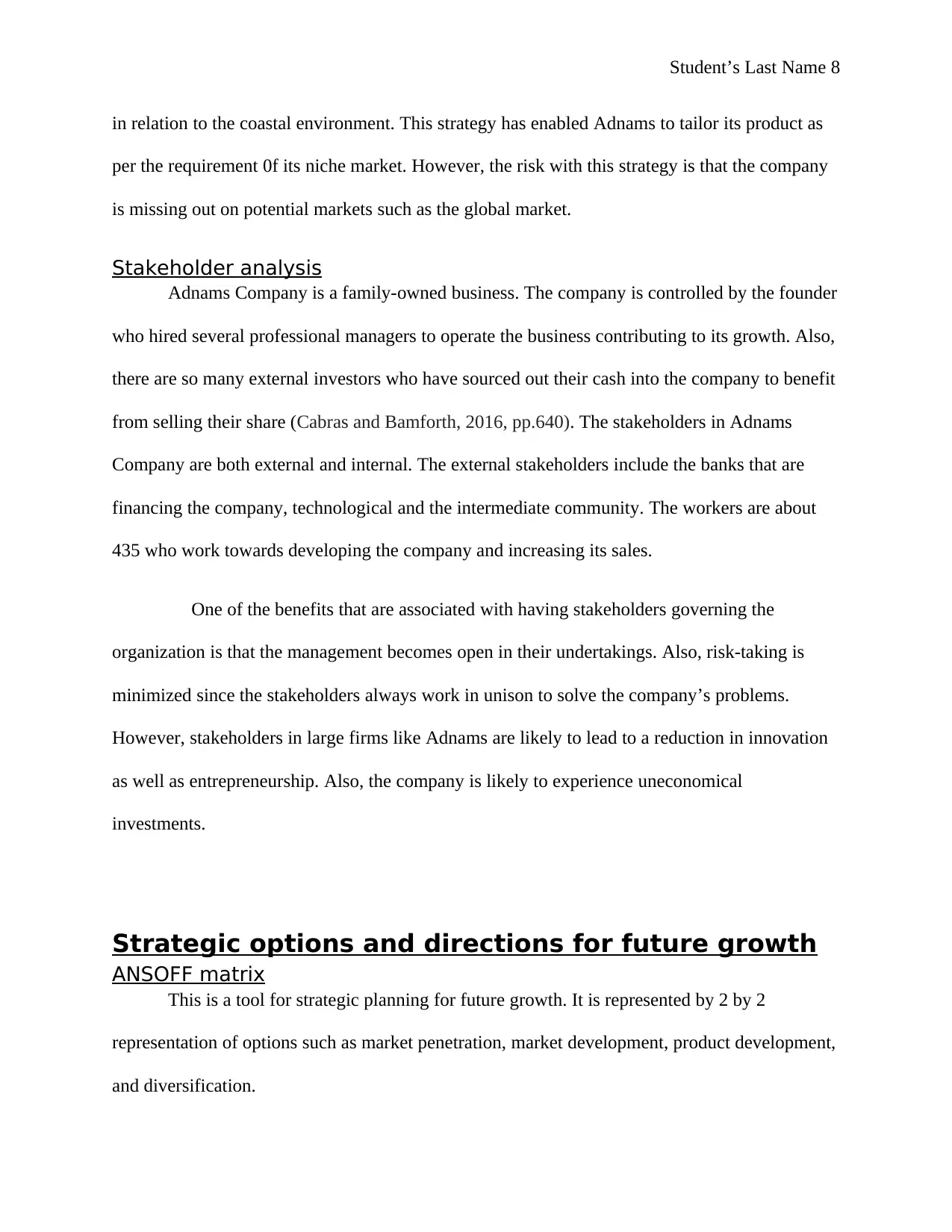
Student’s Last Name 8
in relation to the coastal environment. This strategy has enabled Adnams to tailor its product as
per the requirement 0f its niche market. However, the risk with this strategy is that the company
is missing out on potential markets such as the global market.
Stakeholder analysis
Adnams Company is a family-owned business. The company is controlled by the founder
who hired several professional managers to operate the business contributing to its growth. Also,
there are so many external investors who have sourced out their cash into the company to benefit
from selling their share (Cabras and Bamforth, 2016, pp.640). The stakeholders in Adnams
Company are both external and internal. The external stakeholders include the banks that are
financing the company, technological and the intermediate community. The workers are about
435 who work towards developing the company and increasing its sales.
One of the benefits that are associated with having stakeholders governing the
organization is that the management becomes open in their undertakings. Also, risk-taking is
minimized since the stakeholders always work in unison to solve the company’s problems.
However, stakeholders in large firms like Adnams are likely to lead to a reduction in innovation
as well as entrepreneurship. Also, the company is likely to experience uneconomical
investments.
Strategic options and directions for future growth
ANSOFF matrix
This is a tool for strategic planning for future growth. It is represented by 2 by 2
representation of options such as market penetration, market development, product development,
and diversification.
in relation to the coastal environment. This strategy has enabled Adnams to tailor its product as
per the requirement 0f its niche market. However, the risk with this strategy is that the company
is missing out on potential markets such as the global market.
Stakeholder analysis
Adnams Company is a family-owned business. The company is controlled by the founder
who hired several professional managers to operate the business contributing to its growth. Also,
there are so many external investors who have sourced out their cash into the company to benefit
from selling their share (Cabras and Bamforth, 2016, pp.640). The stakeholders in Adnams
Company are both external and internal. The external stakeholders include the banks that are
financing the company, technological and the intermediate community. The workers are about
435 who work towards developing the company and increasing its sales.
One of the benefits that are associated with having stakeholders governing the
organization is that the management becomes open in their undertakings. Also, risk-taking is
minimized since the stakeholders always work in unison to solve the company’s problems.
However, stakeholders in large firms like Adnams are likely to lead to a reduction in innovation
as well as entrepreneurship. Also, the company is likely to experience uneconomical
investments.
Strategic options and directions for future growth
ANSOFF matrix
This is a tool for strategic planning for future growth. It is represented by 2 by 2
representation of options such as market penetration, market development, product development,
and diversification.
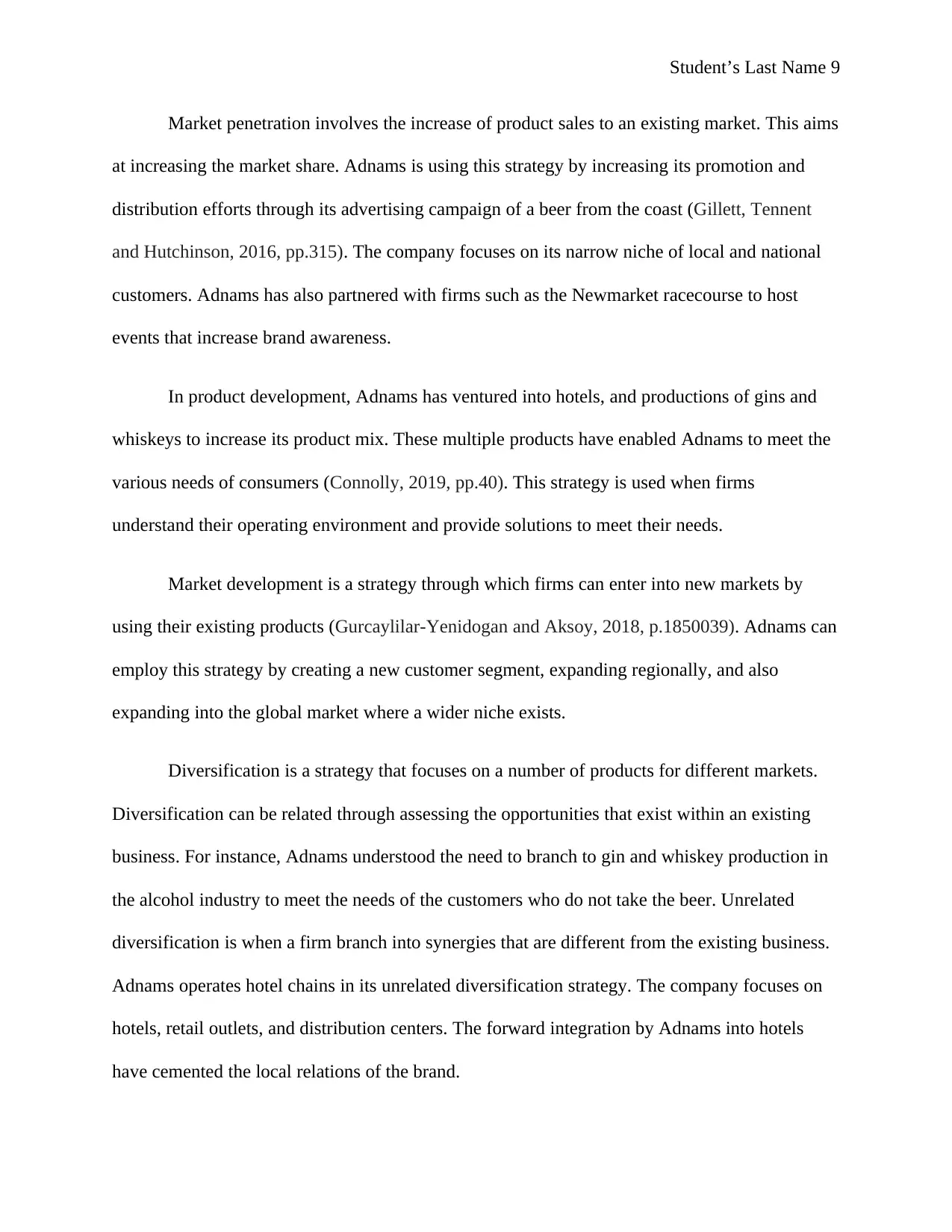
Student’s Last Name 9
Market penetration involves the increase of product sales to an existing market. This aims
at increasing the market share. Adnams is using this strategy by increasing its promotion and
distribution efforts through its advertising campaign of a beer from the coast (Gillett, Tennent
and Hutchinson, 2016, pp.315). The company focuses on its narrow niche of local and national
customers. Adnams has also partnered with firms such as the Newmarket racecourse to host
events that increase brand awareness.
In product development, Adnams has ventured into hotels, and productions of gins and
whiskeys to increase its product mix. These multiple products have enabled Adnams to meet the
various needs of consumers (Connolly, 2019, pp.40). This strategy is used when firms
understand their operating environment and provide solutions to meet their needs.
Market development is a strategy through which firms can enter into new markets by
using their existing products (Gurcaylilar-Yenidogan and Aksoy, 2018, p.1850039). Adnams can
employ this strategy by creating a new customer segment, expanding regionally, and also
expanding into the global market where a wider niche exists.
Diversification is a strategy that focuses on a number of products for different markets.
Diversification can be related through assessing the opportunities that exist within an existing
business. For instance, Adnams understood the need to branch to gin and whiskey production in
the alcohol industry to meet the needs of the customers who do not take the beer. Unrelated
diversification is when a firm branch into synergies that are different from the existing business.
Adnams operates hotel chains in its unrelated diversification strategy. The company focuses on
hotels, retail outlets, and distribution centers. The forward integration by Adnams into hotels
have cemented the local relations of the brand.
Market penetration involves the increase of product sales to an existing market. This aims
at increasing the market share. Adnams is using this strategy by increasing its promotion and
distribution efforts through its advertising campaign of a beer from the coast (Gillett, Tennent
and Hutchinson, 2016, pp.315). The company focuses on its narrow niche of local and national
customers. Adnams has also partnered with firms such as the Newmarket racecourse to host
events that increase brand awareness.
In product development, Adnams has ventured into hotels, and productions of gins and
whiskeys to increase its product mix. These multiple products have enabled Adnams to meet the
various needs of consumers (Connolly, 2019, pp.40). This strategy is used when firms
understand their operating environment and provide solutions to meet their needs.
Market development is a strategy through which firms can enter into new markets by
using their existing products (Gurcaylilar-Yenidogan and Aksoy, 2018, p.1850039). Adnams can
employ this strategy by creating a new customer segment, expanding regionally, and also
expanding into the global market where a wider niche exists.
Diversification is a strategy that focuses on a number of products for different markets.
Diversification can be related through assessing the opportunities that exist within an existing
business. For instance, Adnams understood the need to branch to gin and whiskey production in
the alcohol industry to meet the needs of the customers who do not take the beer. Unrelated
diversification is when a firm branch into synergies that are different from the existing business.
Adnams operates hotel chains in its unrelated diversification strategy. The company focuses on
hotels, retail outlets, and distribution centers. The forward integration by Adnams into hotels
have cemented the local relations of the brand.
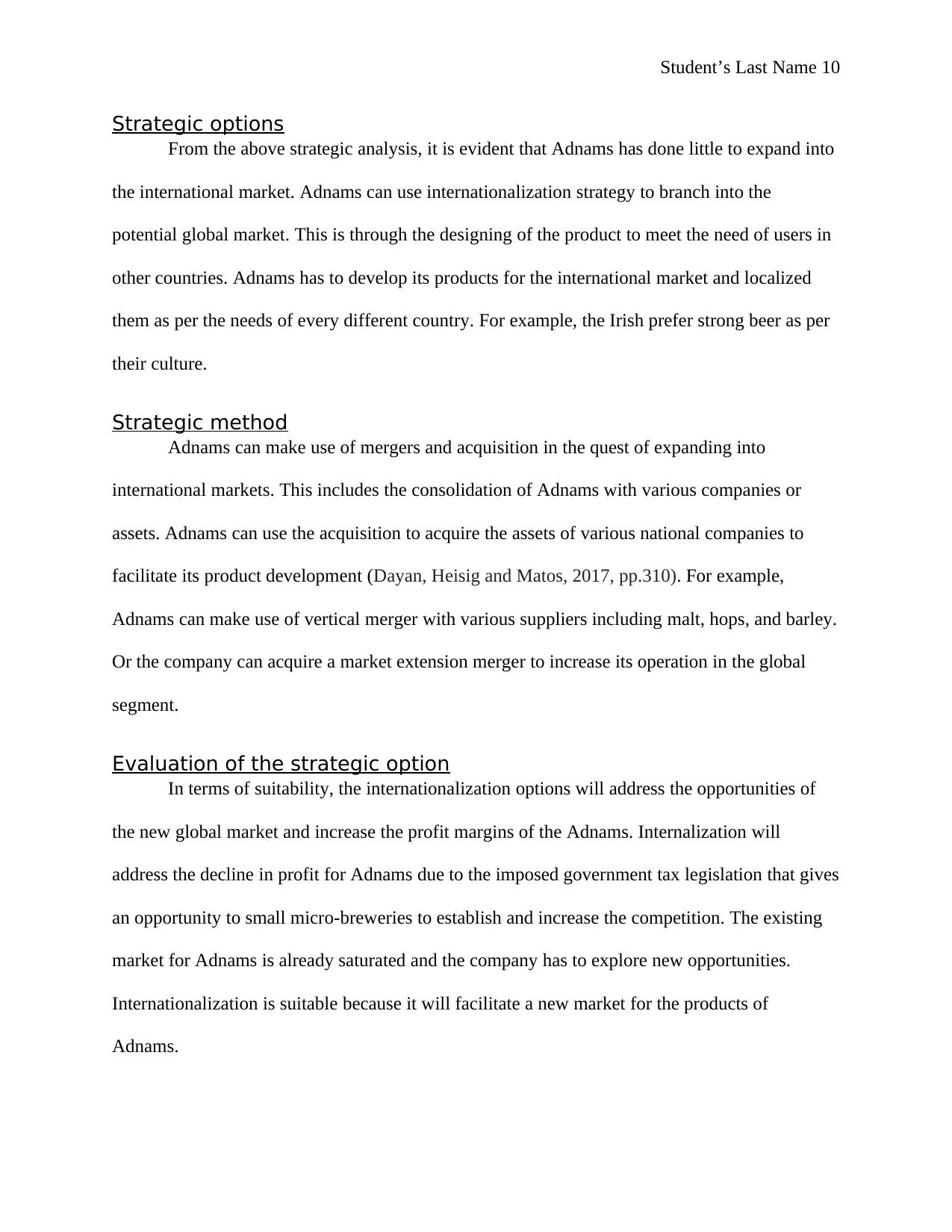
Student’s Last Name 10
Strategic options
From the above strategic analysis, it is evident that Adnams has done little to expand into
the international market. Adnams can use internationalization strategy to branch into the
potential global market. This is through the designing of the product to meet the need of users in
other countries. Adnams has to develop its products for the international market and localized
them as per the needs of every different country. For example, the Irish prefer strong beer as per
their culture.
Strategic method
Adnams can make use of mergers and acquisition in the quest of expanding into
international markets. This includes the consolidation of Adnams with various companies or
assets. Adnams can use the acquisition to acquire the assets of various national companies to
facilitate its product development (Dayan, Heisig and Matos, 2017, pp.310). For example,
Adnams can make use of vertical merger with various suppliers including malt, hops, and barley.
Or the company can acquire a market extension merger to increase its operation in the global
segment.
Evaluation of the strategic option
In terms of suitability, the internationalization options will address the opportunities of
the new global market and increase the profit margins of the Adnams. Internalization will
address the decline in profit for Adnams due to the imposed government tax legislation that gives
an opportunity to small micro-breweries to establish and increase the competition. The existing
market for Adnams is already saturated and the company has to explore new opportunities.
Internationalization is suitable because it will facilitate a new market for the products of
Adnams.
Strategic options
From the above strategic analysis, it is evident that Adnams has done little to expand into
the international market. Adnams can use internationalization strategy to branch into the
potential global market. This is through the designing of the product to meet the need of users in
other countries. Adnams has to develop its products for the international market and localized
them as per the needs of every different country. For example, the Irish prefer strong beer as per
their culture.
Strategic method
Adnams can make use of mergers and acquisition in the quest of expanding into
international markets. This includes the consolidation of Adnams with various companies or
assets. Adnams can use the acquisition to acquire the assets of various national companies to
facilitate its product development (Dayan, Heisig and Matos, 2017, pp.310). For example,
Adnams can make use of vertical merger with various suppliers including malt, hops, and barley.
Or the company can acquire a market extension merger to increase its operation in the global
segment.
Evaluation of the strategic option
In terms of suitability, the internationalization options will address the opportunities of
the new global market and increase the profit margins of the Adnams. Internalization will
address the decline in profit for Adnams due to the imposed government tax legislation that gives
an opportunity to small micro-breweries to establish and increase the competition. The existing
market for Adnams is already saturated and the company has to explore new opportunities.
Internationalization is suitable because it will facilitate a new market for the products of
Adnams.
Secure Best Marks with AI Grader
Need help grading? Try our AI Grader for instant feedback on your assignments.
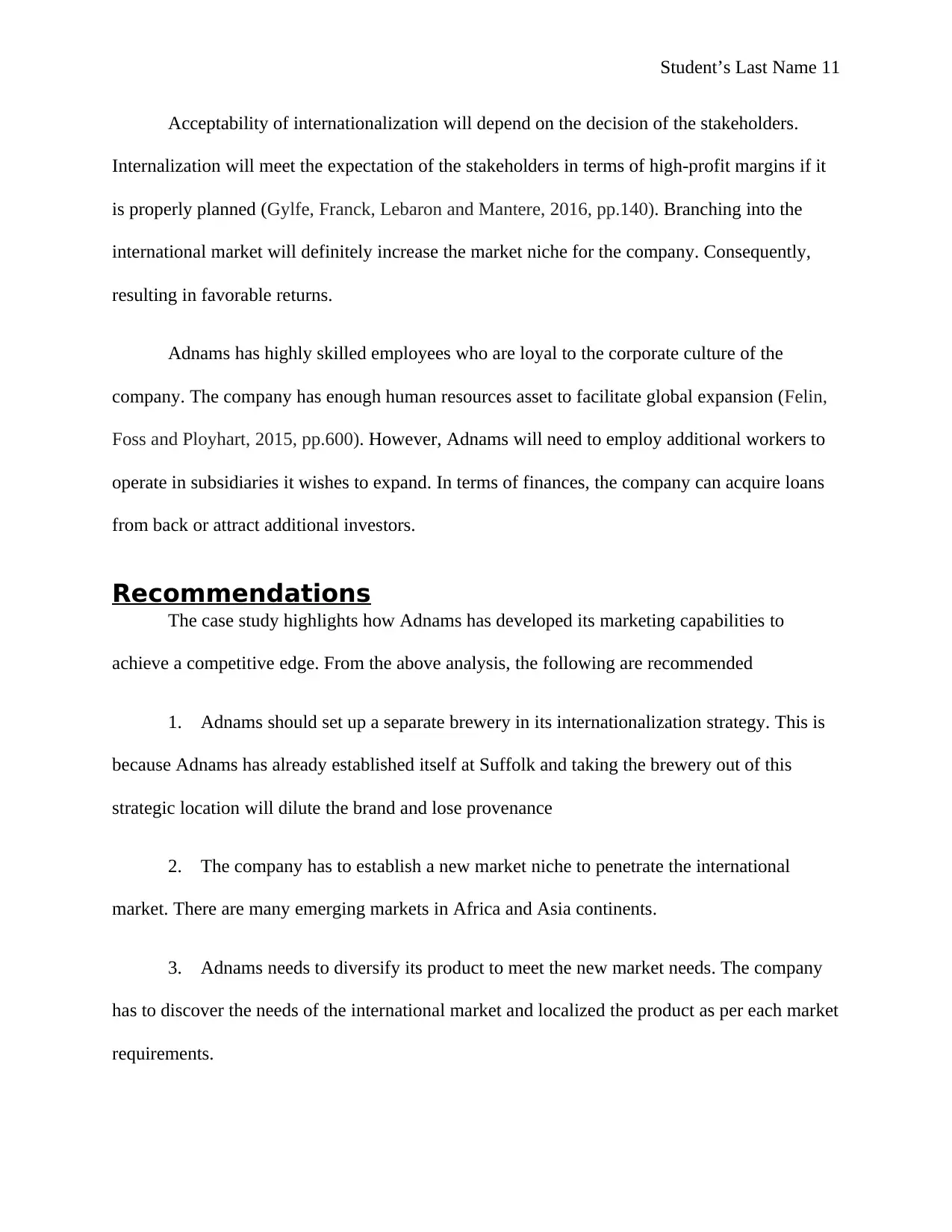
Student’s Last Name 11
Acceptability of internationalization will depend on the decision of the stakeholders.
Internalization will meet the expectation of the stakeholders in terms of high-profit margins if it
is properly planned (Gylfe, Franck, Lebaron and Mantere, 2016, pp.140). Branching into the
international market will definitely increase the market niche for the company. Consequently,
resulting in favorable returns.
Adnams has highly skilled employees who are loyal to the corporate culture of the
company. The company has enough human resources asset to facilitate global expansion (Felin,
Foss and Ployhart, 2015, pp.600). However, Adnams will need to employ additional workers to
operate in subsidiaries it wishes to expand. In terms of finances, the company can acquire loans
from back or attract additional investors.
Recommendations
The case study highlights how Adnams has developed its marketing capabilities to
achieve a competitive edge. From the above analysis, the following are recommended
1. Adnams should set up a separate brewery in its internationalization strategy. This is
because Adnams has already established itself at Suffolk and taking the brewery out of this
strategic location will dilute the brand and lose provenance
2. The company has to establish a new market niche to penetrate the international
market. There are many emerging markets in Africa and Asia continents.
3. Adnams needs to diversify its product to meet the new market needs. The company
has to discover the needs of the international market and localized the product as per each market
requirements.
Acceptability of internationalization will depend on the decision of the stakeholders.
Internalization will meet the expectation of the stakeholders in terms of high-profit margins if it
is properly planned (Gylfe, Franck, Lebaron and Mantere, 2016, pp.140). Branching into the
international market will definitely increase the market niche for the company. Consequently,
resulting in favorable returns.
Adnams has highly skilled employees who are loyal to the corporate culture of the
company. The company has enough human resources asset to facilitate global expansion (Felin,
Foss and Ployhart, 2015, pp.600). However, Adnams will need to employ additional workers to
operate in subsidiaries it wishes to expand. In terms of finances, the company can acquire loans
from back or attract additional investors.
Recommendations
The case study highlights how Adnams has developed its marketing capabilities to
achieve a competitive edge. From the above analysis, the following are recommended
1. Adnams should set up a separate brewery in its internationalization strategy. This is
because Adnams has already established itself at Suffolk and taking the brewery out of this
strategic location will dilute the brand and lose provenance
2. The company has to establish a new market niche to penetrate the international
market. There are many emerging markets in Africa and Asia continents.
3. Adnams needs to diversify its product to meet the new market needs. The company
has to discover the needs of the international market and localized the product as per each market
requirements.
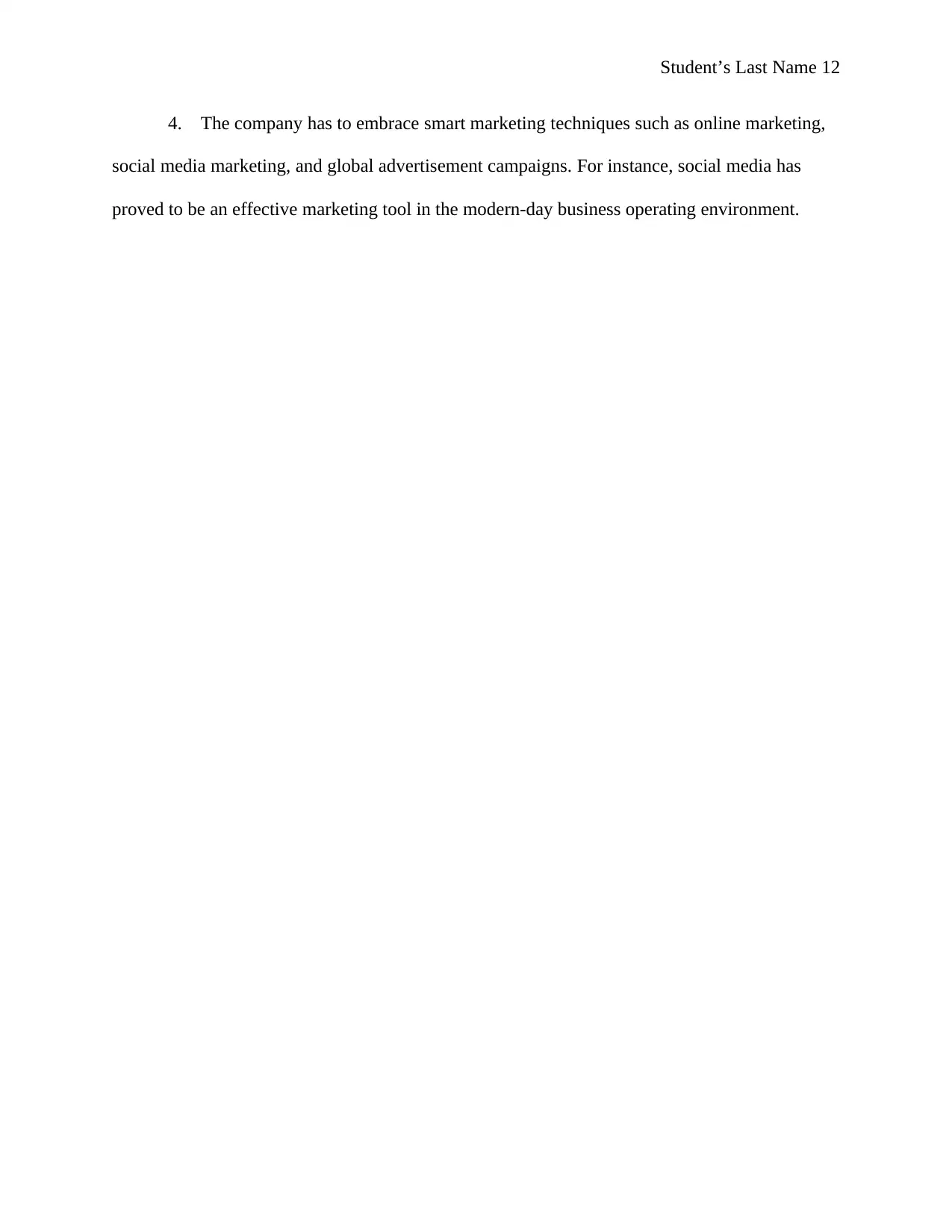
Student’s Last Name 12
4. The company has to embrace smart marketing techniques such as online marketing,
social media marketing, and global advertisement campaigns. For instance, social media has
proved to be an effective marketing tool in the modern-day business operating environment.
4. The company has to embrace smart marketing techniques such as online marketing,
social media marketing, and global advertisement campaigns. For instance, social media has
proved to be an effective marketing tool in the modern-day business operating environment.
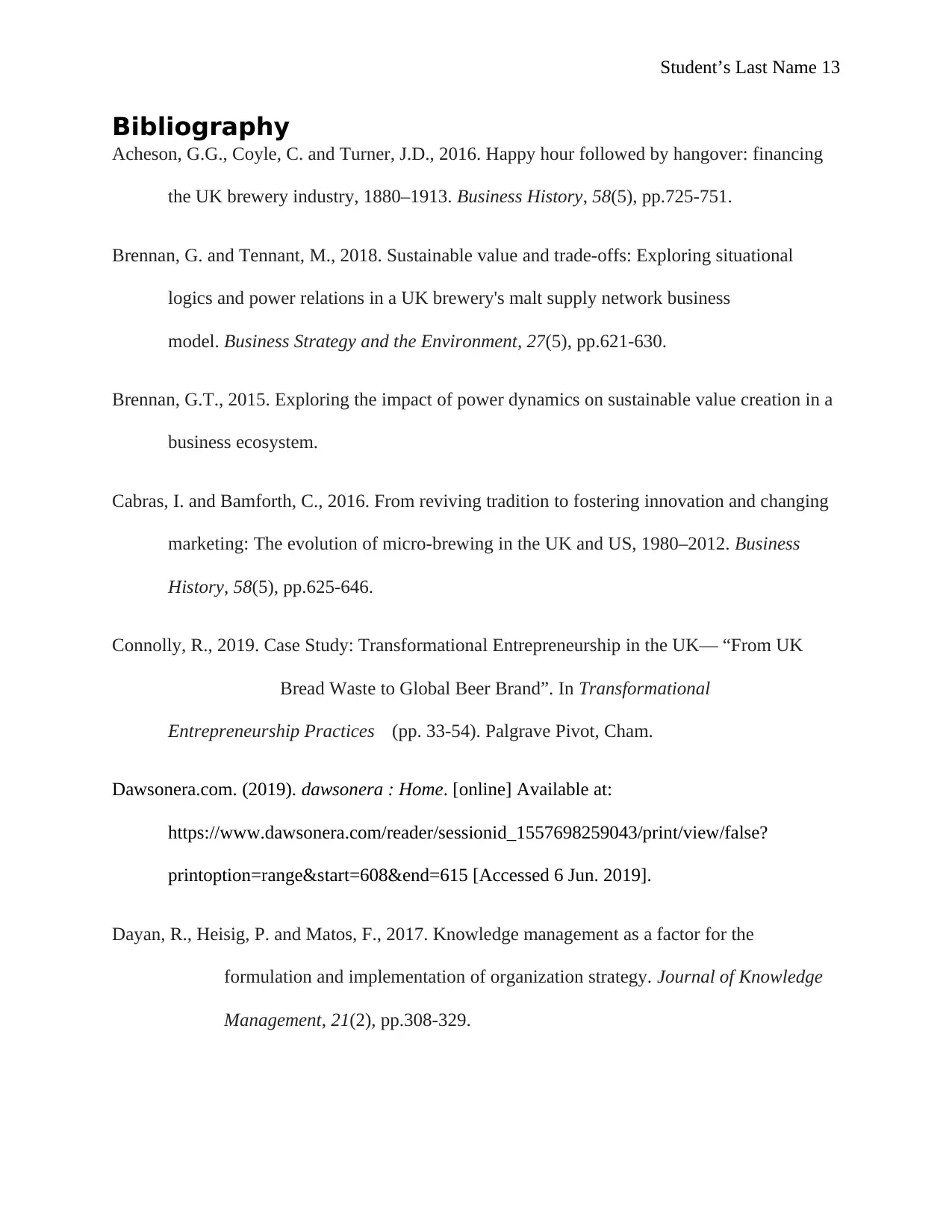
Student’s Last Name 13
Bibliography
Acheson, G.G., Coyle, C. and Turner, J.D., 2016. Happy hour followed by hangover: financing
the UK brewery industry, 1880–1913. Business History, 58(5), pp.725-751.
Brennan, G. and Tennant, M., 2018. Sustainable value and trade‐offs: Exploring situational
logics and power relations in a UK brewery's malt supply network business
model. Business Strategy and the Environment, 27(5), pp.621-630.
Brennan, G.T., 2015. Exploring the impact of power dynamics on sustainable value creation in a
business ecosystem.
Cabras, I. and Bamforth, C., 2016. From reviving tradition to fostering innovation and changing
marketing: The evolution of micro-brewing in the UK and US, 1980–2012. Business
History, 58(5), pp.625-646.
Connolly, R., 2019. Case Study: Transformational Entrepreneurship in the UK— “From UK
Bread Waste to Global Beer Brand”. In Transformational
Entrepreneurship Practices (pp. 33-54). Palgrave Pivot, Cham.
Dawsonera.com. (2019). dawsonera : Home. [online] Available at:
https://www.dawsonera.com/reader/sessionid_1557698259043/print/view/false?
printoption=range&start=608&end=615 [Accessed 6 Jun. 2019].
Dayan, R., Heisig, P. and Matos, F., 2017. Knowledge management as a factor for the
formulation and implementation of organization strategy. Journal of Knowledge
Management, 21(2), pp.308-329.
Bibliography
Acheson, G.G., Coyle, C. and Turner, J.D., 2016. Happy hour followed by hangover: financing
the UK brewery industry, 1880–1913. Business History, 58(5), pp.725-751.
Brennan, G. and Tennant, M., 2018. Sustainable value and trade‐offs: Exploring situational
logics and power relations in a UK brewery's malt supply network business
model. Business Strategy and the Environment, 27(5), pp.621-630.
Brennan, G.T., 2015. Exploring the impact of power dynamics on sustainable value creation in a
business ecosystem.
Cabras, I. and Bamforth, C., 2016. From reviving tradition to fostering innovation and changing
marketing: The evolution of micro-brewing in the UK and US, 1980–2012. Business
History, 58(5), pp.625-646.
Connolly, R., 2019. Case Study: Transformational Entrepreneurship in the UK— “From UK
Bread Waste to Global Beer Brand”. In Transformational
Entrepreneurship Practices (pp. 33-54). Palgrave Pivot, Cham.
Dawsonera.com. (2019). dawsonera : Home. [online] Available at:
https://www.dawsonera.com/reader/sessionid_1557698259043/print/view/false?
printoption=range&start=608&end=615 [Accessed 6 Jun. 2019].
Dayan, R., Heisig, P. and Matos, F., 2017. Knowledge management as a factor for the
formulation and implementation of organization strategy. Journal of Knowledge
Management, 21(2), pp.308-329.
Paraphrase This Document
Need a fresh take? Get an instant paraphrase of this document with our AI Paraphraser
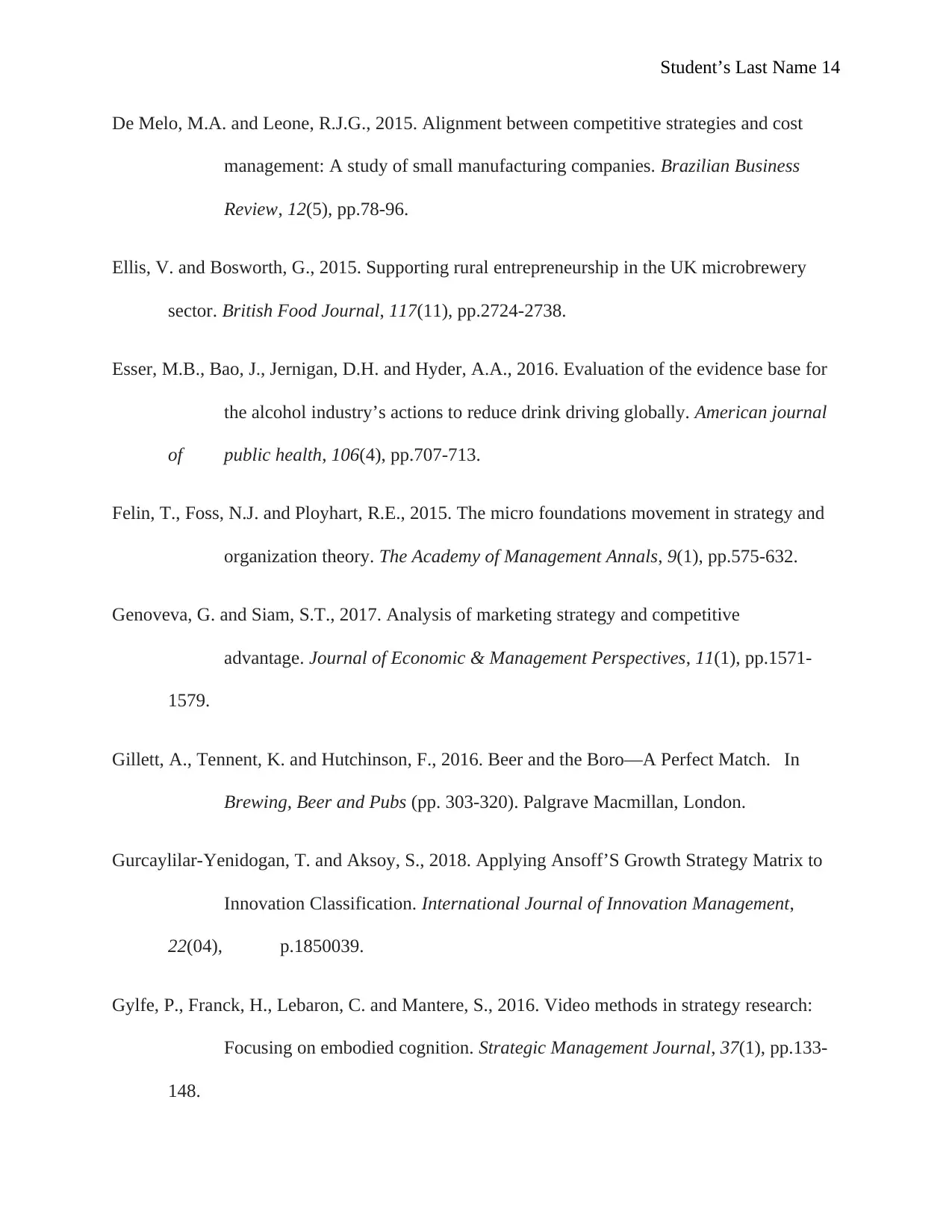
Student’s Last Name 14
De Melo, M.A. and Leone, R.J.G., 2015. Alignment between competitive strategies and cost
management: A study of small manufacturing companies. Brazilian Business
Review, 12(5), pp.78-96.
Ellis, V. and Bosworth, G., 2015. Supporting rural entrepreneurship in the UK microbrewery
sector. British Food Journal, 117(11), pp.2724-2738.
Esser, M.B., Bao, J., Jernigan, D.H. and Hyder, A.A., 2016. Evaluation of the evidence base for
the alcohol industry’s actions to reduce drink driving globally. American journal
of public health, 106(4), pp.707-713.
Felin, T., Foss, N.J. and Ployhart, R.E., 2015. The micro foundations movement in strategy and
organization theory. The Academy of Management Annals, 9(1), pp.575-632.
Genoveva, G. and Siam, S.T., 2017. Analysis of marketing strategy and competitive
advantage. Journal of Economic & Management Perspectives, 11(1), pp.1571-
1579.
Gillett, A., Tennent, K. and Hutchinson, F., 2016. Beer and the Boro—A Perfect Match. In
Brewing, Beer and Pubs (pp. 303-320). Palgrave Macmillan, London.
Gurcaylilar-Yenidogan, T. and Aksoy, S., 2018. Applying Ansoff’S Growth Strategy Matrix to
Innovation Classification. International Journal of Innovation Management,
22(04), p.1850039.
Gylfe, P., Franck, H., Lebaron, C. and Mantere, S., 2016. Video methods in strategy research:
Focusing on embodied cognition. Strategic Management Journal, 37(1), pp.133-
148.
De Melo, M.A. and Leone, R.J.G., 2015. Alignment between competitive strategies and cost
management: A study of small manufacturing companies. Brazilian Business
Review, 12(5), pp.78-96.
Ellis, V. and Bosworth, G., 2015. Supporting rural entrepreneurship in the UK microbrewery
sector. British Food Journal, 117(11), pp.2724-2738.
Esser, M.B., Bao, J., Jernigan, D.H. and Hyder, A.A., 2016. Evaluation of the evidence base for
the alcohol industry’s actions to reduce drink driving globally. American journal
of public health, 106(4), pp.707-713.
Felin, T., Foss, N.J. and Ployhart, R.E., 2015. The micro foundations movement in strategy and
organization theory. The Academy of Management Annals, 9(1), pp.575-632.
Genoveva, G. and Siam, S.T., 2017. Analysis of marketing strategy and competitive
advantage. Journal of Economic & Management Perspectives, 11(1), pp.1571-
1579.
Gillett, A., Tennent, K. and Hutchinson, F., 2016. Beer and the Boro—A Perfect Match. In
Brewing, Beer and Pubs (pp. 303-320). Palgrave Macmillan, London.
Gurcaylilar-Yenidogan, T. and Aksoy, S., 2018. Applying Ansoff’S Growth Strategy Matrix to
Innovation Classification. International Journal of Innovation Management,
22(04), p.1850039.
Gylfe, P., Franck, H., Lebaron, C. and Mantere, S., 2016. Video methods in strategy research:
Focusing on embodied cognition. Strategic Management Journal, 37(1), pp.133-
148.
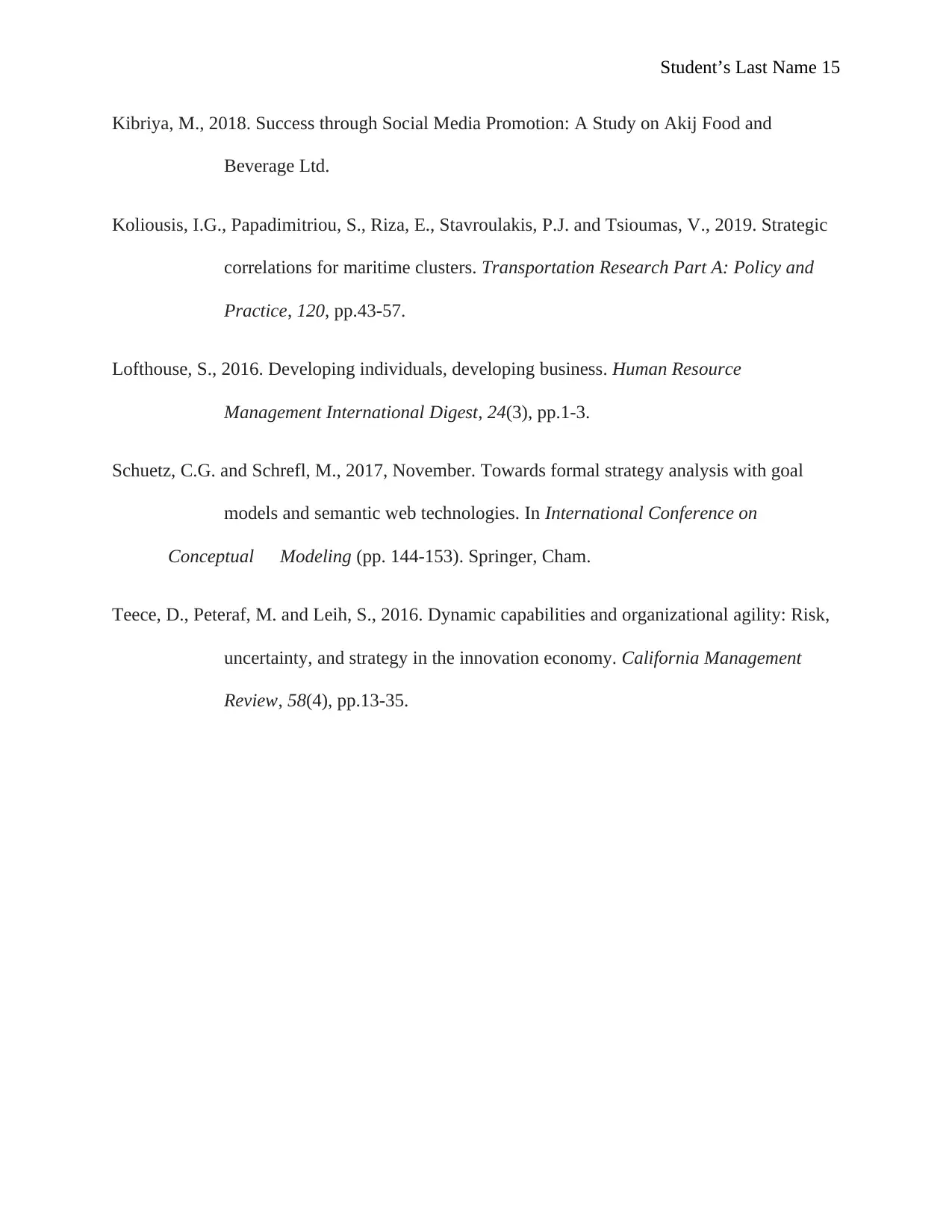
Student’s Last Name 15
Kibriya, M., 2018. Success through Social Media Promotion: A Study on Akij Food and
Beverage Ltd.
Koliousis, I.G., Papadimitriou, S., Riza, E., Stavroulakis, P.J. and Tsioumas, V., 2019. Strategic
correlations for maritime clusters. Transportation Research Part A: Policy and
Practice, 120, pp.43-57.
Lofthouse, S., 2016. Developing individuals, developing business. Human Resource
Management International Digest, 24(3), pp.1-3.
Schuetz, C.G. and Schrefl, M., 2017, November. Towards formal strategy analysis with goal
models and semantic web technologies. In International Conference on
Conceptual Modeling (pp. 144-153). Springer, Cham.
Teece, D., Peteraf, M. and Leih, S., 2016. Dynamic capabilities and organizational agility: Risk,
uncertainty, and strategy in the innovation economy. California Management
Review, 58(4), pp.13-35.
Kibriya, M., 2018. Success through Social Media Promotion: A Study on Akij Food and
Beverage Ltd.
Koliousis, I.G., Papadimitriou, S., Riza, E., Stavroulakis, P.J. and Tsioumas, V., 2019. Strategic
correlations for maritime clusters. Transportation Research Part A: Policy and
Practice, 120, pp.43-57.
Lofthouse, S., 2016. Developing individuals, developing business. Human Resource
Management International Digest, 24(3), pp.1-3.
Schuetz, C.G. and Schrefl, M., 2017, November. Towards formal strategy analysis with goal
models and semantic web technologies. In International Conference on
Conceptual Modeling (pp. 144-153). Springer, Cham.
Teece, D., Peteraf, M. and Leih, S., 2016. Dynamic capabilities and organizational agility: Risk,
uncertainty, and strategy in the innovation economy. California Management
Review, 58(4), pp.13-35.
1 out of 15
Related Documents
Your All-in-One AI-Powered Toolkit for Academic Success.
+13062052269
info@desklib.com
Available 24*7 on WhatsApp / Email
![[object Object]](/_next/static/media/star-bottom.7253800d.svg)
Unlock your academic potential
© 2024 | Zucol Services PVT LTD | All rights reserved.





